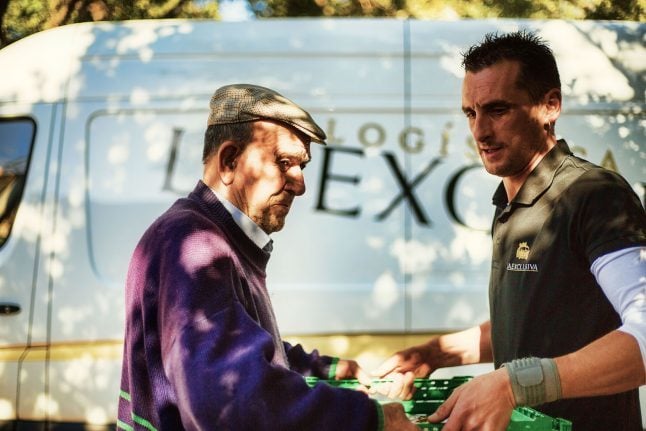When someone says ‘Swedish Chef’ it’s probably most often associated with the verbally-challenged Muppet and his oddball kitchen antics from the popular 1970s television show.
But a group of would-be Swedish chefs from the north of the country have used YouTube to put an entirely new and even more outrageous spin on the preparation of traditional Swedish food.
Mashing vegetables by slamming them in a door and body slamming onions are just a few of the unorthodox methods employed by the creators of Regular Ordinary Swedish Meal Time (ROSMT).
And while dishes such as head-butted meatballs and face-scrubbed potatoes – often preceded by the gulping down of a heaping spoonful of mayonnaise – may leave some feeling queasy, episodes of ROSMT have been viewed millions of times since the show’s launch earlier this year, making it one of the most popular Swedish cooking shows in cyberspace.
And it all started with a hangover meal.
Isak Anklew and Niclas Lundberg, both 24, were preparing some food to help them recover from an extended evening of celebrations to ring in the 2011 New Year when inspiration struck.
They felt creative, despite their diminished energy reserves, and came up with the idea to do something fun with their cooking that they could post on YouTube.
“I know Niclas from way back, and I knew he could freak out and it would come out great on film,” Anklew, who works as an iPhone developer, tells The Local.
“We were inspired by ‘Epic Meal Time’. We’ve seen a lot of their clips and love what they do.”
Epic Meal Time is a YouTube sensation out of Canada where a group of young men cook greasy food in an innovative and slightly aggressive manner.
ROSMT’s pilot episode “Spaghetti Explosion”, in which Lundberg pummels minced meat with his fists while scowling at the camera, attempted to put a Swedish twist on the Canadian show.
After first being spread among the friends of Lundberg and Anklew, the video quickly received thousands of views, inspiring them to keep going.
When ROSMT showed how to effectively grease a pan with one’s face in their third video, “Sidepork Pandemonium”, it was picked up by on the news aggregate site Reddit.com.
Suddenly, the offbeat and barbaric Swedish cooking show was a global phenomenon.
“We got 200,000 views in a day which really gave us a boost, and that pretty much started this carousel,” Anklew says.
“That’s when it went viral I guess you could say, and it was pretty obvious when it happened.”
Since then, the group’s internet fame has given them little breathing space.
The number of subscribers to their YouTube channel has steadily increased, forcing the group to eat things that others might have chosen to decline.
“I like mayonnaise so it’s really not a problem to eat a spoonful like that, but I wouldn’t eat a whole jar of it,” says Lundberg, who enjoys a sizeable swallow of mayonnaise as a pre-dinner snack in each episode.
“But some things like the crayfish shell we can’t eat, that would probably be a hazard to our health.”
Anklew and Lundberg have a couple of theories as to why their rather simple format cooking show has proven so popular.
According to Anklew, the contrast between the image of Swedes as neutral and careful in most aspects of life, and the aggressive visuals of the show, adds to the comedy.
“No one really expects us to trash the kitchen,” he says.
Lundberg points to the sensibilities of an audience that came of age after the dawn of the internet era.
“We’re born into this internet generation. We spend lots of time surfing the web and I think we’ve always had an eye for what people want to see,” he says.
“If we think it’s funny, others will think so too. The best things we’ve done we’ve also laughed like crazy to.”
And they’re not only advocates of this particular type of humour, but also the format of easily accessible, short video clips.
Having studied how to make appealing YouTube media, Lundberg and team member Niklas Odén, 25, know the “dos and dont’s” of the enormous virtual platform, including keeping clips short and action packed to appeal to the shorter attention span of internet media consumers.
Another reason ROSMT has proven popular outside Sweden might be the show’s sporadic use of the international language “Swenglish”.
However, the main language is, and will remain Swedish, even though some viewers are requesting subtitles.
“We were strongly opposed to the idea of subtitles right from the start,” Lundberg says.
“Some even say it’s a lot funnier because they don’t understand a word of what we say. Swedish is kind of exotic in itself.”
In this day and age it’s not uncommon to receive tens of thousands of hits on sites like YouTube, but many viral videos are merely one hit wonders.
ROSMT episodes, however, have amassed nearly 30 million clip views, and almost 200,000 subscribers, and the gang is determined to keep the project going.
But it hasn’t been easy.
At the moment the five members, also including Tom Brännström, 24, and Anders Söderman, 30, live in different parts of Sweden and have different jobs, meaning the opportunity to record a clip doesn’t come as often as they’d like.
“The dream is to do more stuff and have more time for it,” says Lundberg, who is getting a masters in Cross Media Interaction Design at Umeå University in Skellefteå, in northern Sweden.
“It’d be fun to see if we could do more besides cooking and see if people would like that too. But that’s wishful thinking right now.”
So for now, most communication is done via Skype, where new ideas for tasty, messy meals flourish.
They’re still “flat broke” as Lundberg put it, but at least their YouTube success has enabled them to buy and smash food for new episodes.




 Please whitelist us to continue reading.
Please whitelist us to continue reading.
Member comments